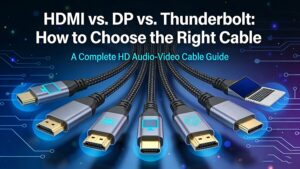Confused by USB-C cables? You’re not alone. With 2025 bringing faster protocols like USB4 and Thunderbolt 5, plus 240W charging options, picking the right cable feels overwhelming. This guide cuts through the jargon—so you can choose based on speed, power, and your actual needs.
Key Protocols & Transfer Speeds (2025 Update)
Not all USB-C cables are equal—their performance depends on the underlying protocol. Here’s what you need to know:
| Protocolo | Max Transfer Speed | Key Use Cases |
|---|---|---|
| USB 2.0 | 480 Mbps (0.48 Gbps) | Basic charging, slow file transfers (e.g., photos) |
| USB 3.2 Gen 2 | 10 Gbps | HD video streaming, regular file transfers |
| USB4 | 40 Gbps | Laptop backups, external SSDs, dual 4K displays |
| Thunderbolt 4 | 40 Gbps | Professional workflows, docked setups |
| Thunderbolt 5 | 80 Gbps (120 Gbps asymmetric) | 8K HDR video, 540Hz gaming, 240W laptop charging |
240W High-Power Cables: Materials & Must-Haves
Core Material Features
Critical Note
How to Identify Cable Specs Fast (2025 New Labels)
USB-IF’s 2025 simplified system makes it easy to spot specs at a glance :
Quick Identification Tips
Visual Cheat Sheet







